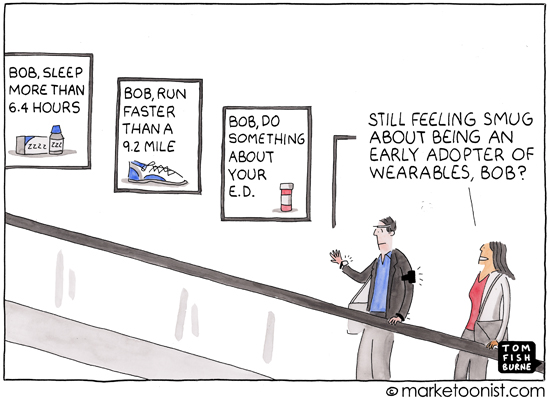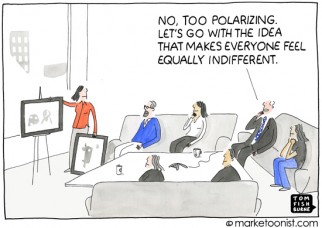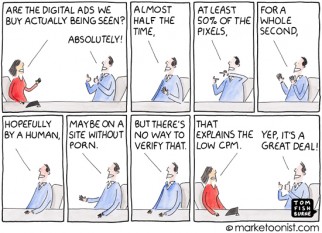I heard recently that the average person checks their mobile 150 times a day. From a marketer’s perspective, that’s a lot of potential touch points — both in collecting data and in messaging. But it pales in comparison to the staggering world of wearables.
Technology is giving unparalleled access for marketers to understand consumers, and to reach them in a highly relevant and targeted way. But we’re going to be in the Wild West for a while. It’s not clear what marketing will be welcome and what will be considered invasive. There’s a fine line between relevant and creepy. If you think retargeting ads that follow you across the web after viewing a lamp on Amazon are annoying, just wait for when wearables are mainstream.
I’m interested to see how brands will navigate the promise and pitfalls of wearable technology. There’s already talk about the importance of privacy. But I think it goes beyond respecting privacy. I think it goes to the heart of permission marketing that Seth Godin has been advocating for years. What is irritating about an unsolicited spam email will be even more so when extended to wearables.
“Permission marketing is the privilege (not the right) of delivering anticipated, personal and relevant messages to people who actually want to get them.
“It recognizes the new power of the best consumers to ignore marketing. It realizes that treating people with respect is the best way to earn their attention.”
I think the key will be in making it easy for consumers to engage with your brand on their terms, whether on a small screen or no screen at all. That means thinking through all of the opportunities a brand can be genuinely useful to the audiences those brands are trying to serve. It means offering the most relevant communication but also knowing when not to communicate at all. It’s not just about new touch points for the same old messaging.
I’d love to hear your thoughts on rules of thumb for experimenting with this new technology.
(Marketoonist Monday: I’m giving away a signed cartoon print. Just share an insightful comment to this week’s post by 5:00 PST on Monday. Thanks!)



Stephanie says
The thought of this stuff following me round is nightmarish! A lot of the targeted ads are already way off beam and very irritating. Which world would I rather live in Bladerunner or Outlander? Tough choice!
Daniel Johnson Jr says
I’m struck by how technology has essentially created a population of people with attention deficit disorder. I don’t own any wearables, yet, but I anticipate getting something in the next year or so. Right now I am working hard to just disconnect at night from technology so that I can have better sleep. I’m not sure how I feel about having technology monitor my sleep for me.
Concetta says
Daniel, it can be as intrusive or as minimal as you want. I use a FitBit. It monitors my sleep and my steps. Between the two, I use it to make sure I’m averaging 10K steps per day and at least 7 hours of sleep a night.
But that means unlike most people, I only check mine about once a week to see if my average is on target. Some folks get obsessed and really into the data, and others don’t. How you use a wearable is up to you, really.
Daniel Johnson Jr says
I would probably be one who would start off obsessing about the data and then move toward what you’re doing once a week.
Daniel Johnson Jr says
I wonder if it would prompt me when it thinks it’s time for me to buy new running shoes.
Jason King says
As with so many other platforms available to marketers, personalized marketing gathered from wearables data is simply the tool. As with any tool, it falls to the person using it to still be good at their craft or the tool is just another thing for them to make a clunky mess with.
If we are succeed with this tool, it’s hard to imagine that disruptive or even embarrassing messages as in the very funny cartoon will be what moves the needle. Rather, it will be interesting to see who can use these data and insights to put their brand across in the most caring, helpful and still believable way. Instead of Big Brother, how do we position our brand as Big Mother?
Mariana says
The technology will definitely create a LOT of bad targeting/ marketing (just like when you buy something on-lime for others and the internet concludes that you are expecting a baby – I’m never buying gifts for baby showers on line ever again, oy!). I expect two things to happen – the technology providers will differentiate from each other by offering settings and apps where you are invisible or un-targetable, and the best brands will create wearable-inspired content that is so satisfying you WANT to have it (dear chocolate brand, I do allow you to send a funny joke when my stress level is high, together with a coupon for 50% off you candy bar if I get it within an hour… to improve my mood right when I need it). The key thing will be to find the insights on what people WANT… oh, wait, isn’t that what Marketing should be all about anyway?
Ken says
Wearables and other new tech are simply tools that should help marketers deliver more personalized, value-based messages. My Band provides great insight into how well (or not) that I sleep, but falls short of providing helpful guidance on how to improve. Are there products out there that could help me get better sleep? Probably. But beyond simply marketing to them me, I’d be much more interested in learning what has actually helped others who previously had a sleep profile similar to mine.
ABLE Digital Group says
Couldn’t agree more with you Ken. Simply marketing to a target is a “wasted” approach on so many levels because it leaves the door open for missed opportunities. Imagine if you had received a link to a forum/blog/website managed by the parent brand concerning better sleep solutions. Instead of positively being a brand ambassador about the “band”, you most likely sit on-the-fence in speaking for the brand about its’ product…
Tracy Carlson says
One new rule for experimenting with this brave new world of technology would be a truly ancient one: the Golden Rule. What kind of messaging would YOU genuinely welcome seeing? When? And in what context?
Though I shudder at the prospect of clueless, tech-crazed marketers salivating at the prospect of new ways to “get their message out,” perhaps overreach in this area will accelerate a new enthusiasm for privacy and confidentiality in the public. We can only hope!
Rishi M says
One one hand there are many Product Designers, Advertisers and Marketers who see wearables as another opportunity to message the customer. On the other hand there are many Customers who see wearables as a useful way to collect data that can be used to improve their lives. Therefore as a common rule, as owner of the wearable, the customer should have control over the data and decide how and when the Product Designers, Advertisers and Marketers may use the data or message them.
Joseph Kurian says
I have had this conversation with a few people and the intrusiveness of marketing in the wearable world. I don’t think that anyone considers this eventuality to be a positive one after what we have gone through with some poor execution on the desktop, tablet and mobile arenas. What I suggest is that there are extensive controls given to the user of the tech on what they wish to OPT-IN to see. Yes, this removes control from companies being able to sandblast everyone with their messaging, but the conversions from marketing that is selected by an end customer would seem to me to be significantly higher. The cost on the user experience side is for them to spend some time up front to determine exactly what they are open to seeing on their device.